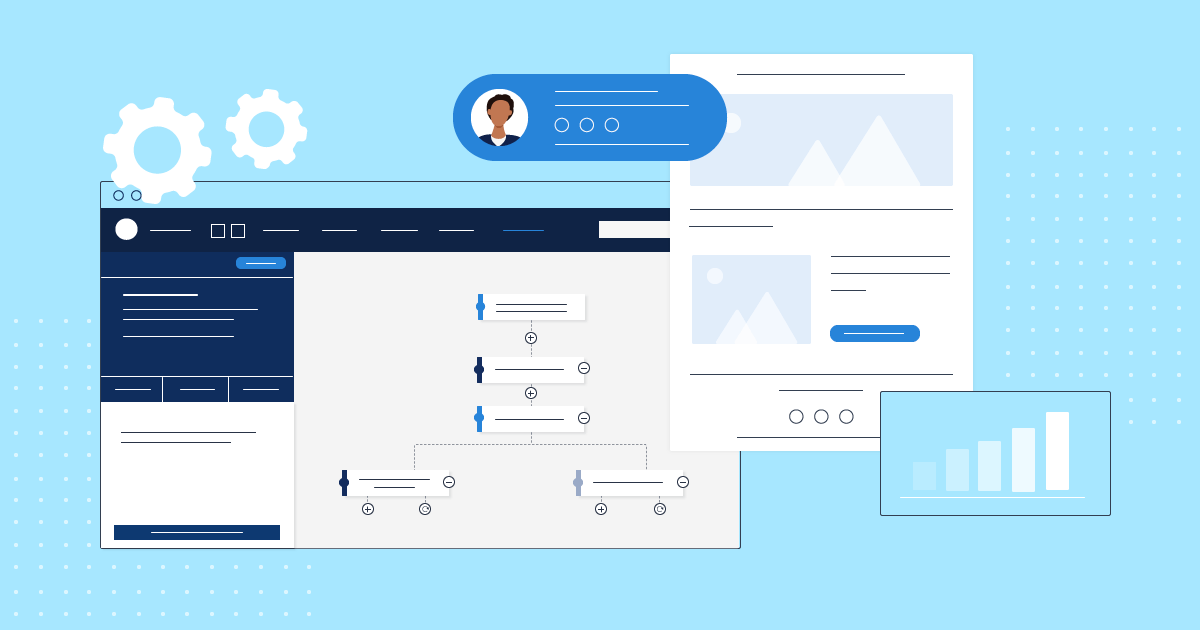
Email Sequences: 9 Types & Best Practices For 2024
Most marketers seek new and efficient methods to personalize customer experiences while keeping their budget low. Moreover, automating part of their processes and operations is a priority, enabling them to save valuable time and focus their energy on strategic projects.
So if you’re searching for optimal ways to move leads down the funnel and turn them into loyal customers, there’s a safe path to follow – email sequences.
In this guide, learn everything you need about automated email sequences to target your customers and prospects with the right messages at the right time. We share the top benefits and email sequence types, including tips on how to set them up successfully.
What Is An Automated Email Sequence?
It’s a series of emails triggered based on specific user actions or behaviors to nurture subscribers during the customer’s journey at critical times. For example, an abandoned cart email sequence aims to increase sales by nudging people who have shown interest in a product.
There are two main types of email sequences: trigger-based and time-based. Trigger-based follow-ups are activated when a visitor or customer has completed a particular action on your website, such as a download.
On the other hand, time-based are sent after a certain amount of time has passed. For example, when someone signs up for your email list, you can automatically set up an email with useful resources or testimonials to start nurturing your audience while they’re warmed up.
To schedule these automated email series, you need email marketing automation software like Moosend or Mailchimp, with a user-friendly dashboard and ready-made automation email templates to free your hands.
What Are The Benefits Of Email Sequences For your Business?
Here are the main advantages:
- Conversions: As long as you send out relevant and timely content to your prospects, for instance, case studies or demo invitations, you increase the chances of moving them down the funnel.
- Sales: When prospects closer to the decision stage receive favored email content from your brand, they gain more trust in you and are more likely to purchase.
- Retention: Finally, it’s important to please repeat and loyal customers with offers or relevant product suggestions to keep a regular interaction with them. Thus, you show them that you value their preferences deeply.
Knowing your customer journey, primary touchpoints, and the time-to-customer conversion rate is essential to reap those benefits. We’ll elaborate more in the next sections.
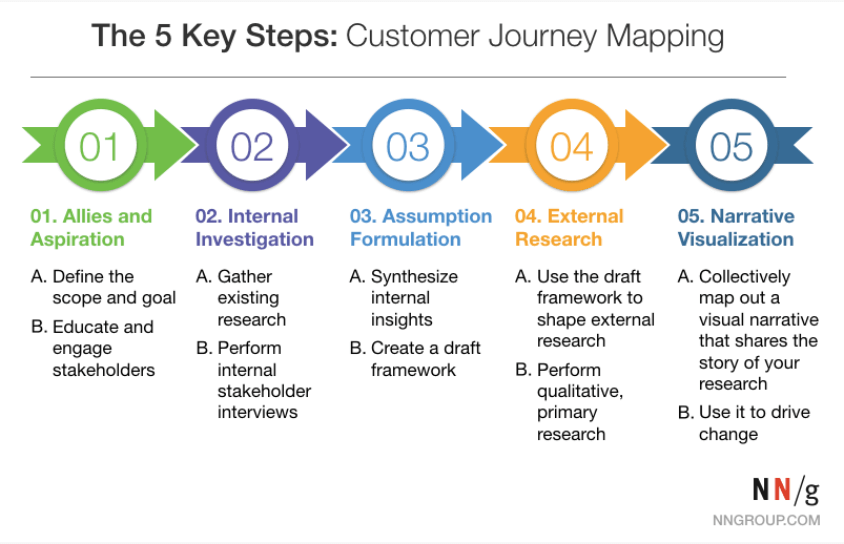
Top Email Sequence Types With Examples
What are the most popular automated email sequences businesses can set up to meet their goals at different customer journey stages? Have a read:
1. Welcome Email Sequence
A welcome email is an ace on every marketer’s sleeve, as it’s the first touchpoint after a prospect or customer has expressed interest in your product/service. With an open rate reaching 57.8% and click-throughs higher than other email types, it’s an excellent opportunity to build momentum.
The calls to action and relevancy play a key role in these sequences. For example, the first email can include a thank-you note and form expectations for future communications. You can send them a list of relevant resources or best-selling products to explore a few days later.
The timeframe from the first welcome to the next in this series depends on the length of the customer journey. Decide what prospects should know about your brand and products/services to entice them to search for more information and consider you seriously.
Let’s have a look at an amazing welcome example by BodyBliss. They have included a welcome note, a free shipping incentive, and two best-selling products to please their readers.
Subject line: Welcome to the Body Bliss Newsletter

What types of emails would you add to this welcome sequence? Maybe including a reminder for the incentive for those who have not purchased yet can be a great choice. Adding customer testimonials showcasing the value of the products is also a suitable idea.
Ready to create your first welcome email sequence? Sign up for a Moosend account, search for our ready-made welcome email sequence, and greet your new subscribers the right way!
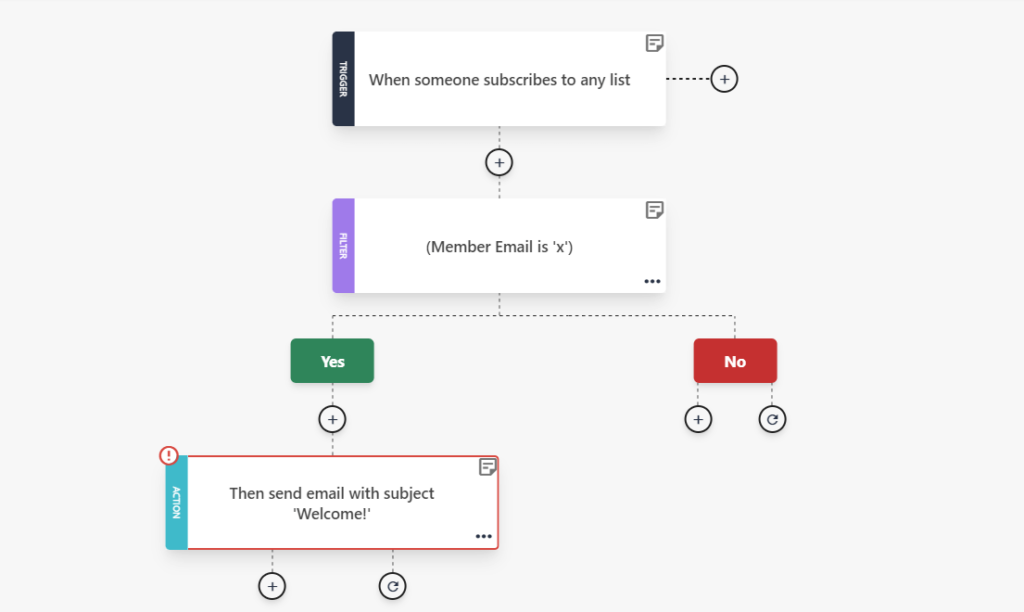
2. Onboarding Email Sequence
Most B2B businesses use onboarding emails to prepare new clients for success. Simultaneously, they reduce redundant customer support tickets, offering essential resources, links, and FAQs to resolve minor issues before they become immense.
Similarly to welcome emails, these email series play an important role in how new customers perceive your brand and can hopefully confirm their decision to choose you among competitors. So design a series of emails that will be rolled out after they join you, including all the small details they need to know to navigate your product/service efficiently.
It helps to consider those email series as part of a step-by-step guide based on the actions new customers need to take upon their purchase. Let’s have a look at two onboarding emails by Vimeo. The first is more generic, including a piece of the most information someone would need to get started:
Subject line: Welcome! Here’s to get started.

The second focuses on the video uploading processes to motivate new users to upload their work without hesitance:
Subject line: Let’s start with an upload.
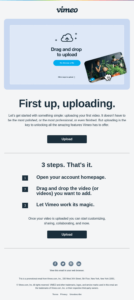
3. Lead Nurturing Email Sequence
When new leads start flowing your way, it’s essential to send regular nurturing email campaigns to capitalize on this positive momentum and maintain a high conversion rate. Personalized email series play an important role in this process, making prospects feel more valued.
So what type of emails fit on this bucket list? Sending out case studies, discounts, and other incentives will enable you to gain your audience’s attention and trust, as long as the content is interesting and tailormade to their needs. For example, eCommerce brands can schedule discounts for new subscribers or prospects that have received different follow-up emails but remain unconverted.
Here’s an example by Loftie, offering a discount to help indecisive prospects finalize their purchase. The design is simple yet attractive, emphasizing the call-to-action button and guidelines on how to claim the discount:
Subject line: Still not sure?

4. Re-engagement Email Sequence
Customer acquisition costs five times more than customer retention. Hence, many marketers employ win-back email tactics to motivate customers to re-engage and hopefully complete a purchase in the near future.
Also known as re-engagement campaigns, you can set up an email series with different content to re-introduce your business to inactive subscribers to retain them for longer. Write an indulging subject line that yields high open rates. This way, you’ll start a conversation with churned customers, emphasizing the benefits they’ll keep reaping if they stay along.
You can kick off this series with an email campaign, including social proof, and continue with a newsletter offering a valuable incentive to those who claim it. As for consistent non-openers, you can send them a “last notice email” informing them that you’ll soon remove them from your email list. Those who don’t want to unsubscribe can give their opt-in again.
For instance, Asana created a smart email campaign including all the features inactive customers have been missing since they’ve been gone, including an eye-catching subject line:
Subject line: You’re missing out on unicorns

5. Cross-sell/Upsell Campaign Series
When designed efficiently, cross-sell and upsell email sequences work miracles for businesses, as they capitalize on customers’ preferences and previous purchases to increase the ROI.
You can start with cross-selling, inviting your customers or prospects to embark on a more holistic experience regarding the products they purchase. For example, if a customer has just purchased a pair of trainers, you can send recommendations for your new gym wear collection.
In most cases, it’s hard to convince a customer to invest in your brand again, especially with up-selling. So you can motivate certain people to invest in a more expensive product/service based on products they’ve recently browsed through your website and similar factors, but not straight after purchase.
You don’t need an extraordinary design and copy to attract the right attention. For instance, a simple yet powerful newsletter like the one below by Backdrop can do the trick:
Subject line: THE BEST-SELLING WHITE PAINT COLOR.
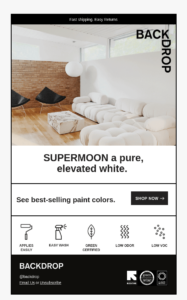
6. Cart Abandonment Series
Many people who indulge in online shopping trust eCommerce stores to purchase their desired products/services. But sometimes, visitors leave items in their shopping without proceeding to the checkout.
Does this mean that they have just ghosted you? Not necessarily, and since they just expressed a real interest in your brand, it’s wise to send them a follow-up email series to remind them of what they left behind.
These so-called abandoned cart email series usually receive high open rates reaching up to 69%. So with the appropriate email content and CTA, they can work wonders. As for non-openers, if you want to nurture and convert them, you can schedule an additional email offering a discount to increase your chances.
To yield higher open and click-through rates, your copy should stand out and motivate readers. This is an inspiring example from Le Puzz for beginners:
Subject line: Missing a puzzle?
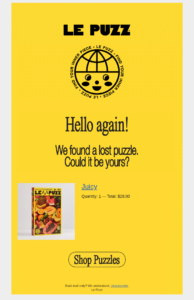
Setting up a successful abandoned cart email is easier than it sounds. Marketing automation tools like Moosend offer premade recipes to create these workflows easily.
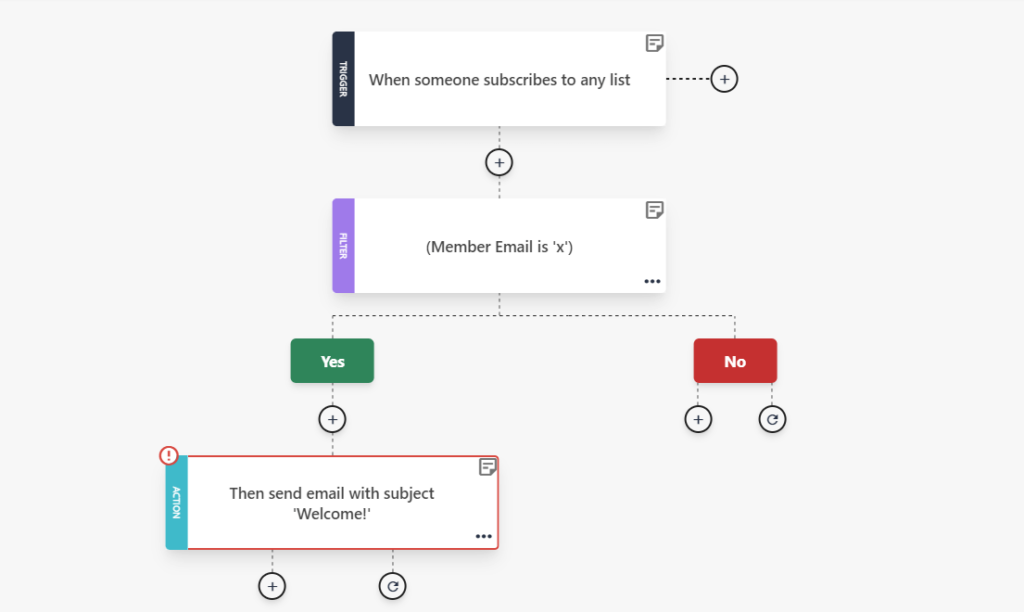
So jump into our newsletter editor, pick one of our beautiful email templates, and nudge prospective customers while they’re in the flow.
7. Renewal Email Sequence
On the road to customer retention, SaaS businesses need to ensure that loyal customers will renew their subscriptions early on. Similarly to re-engagement emails, renewal series are sent as reminders to subscribe again.
Most subscribers will probably open those campaigns and renew before the expiration date, but what can you do for those who miss the deadline? You can extend their subscription for a few days, inform them about it and remind them what they’ll be missing if they don’t act fast.
As for non-openers, you can make a final attempt by offering a discount, especially to loyal or VIP customers. This is how Apple Music invites customers to stay aboard:
Subject line: Your Apple Music membership is almost up.
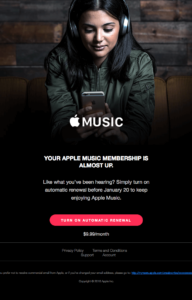
8. Feedback Email Sequence
To improve your products/services and ensure that they can resolve your customers’ needs and meet their preferences, it’s wise to collect their feedback regularly. One of the easiest approaches to adopt is setting up autoresponders and sending them out at critical times during the customer journey.
For example, if you have a B2B eCommerce store, you can nudge them when the shipping is completed and collect data points for all the stages to ensure customer satisfaction. You can also schedule a second version for non-openers to get as much feedback as possible.
Casper created a short newsletter with a call-to-action button leading to the review and a link to the referral program to incentivize happy customers to spread the word and get something valuable in return:
Subject line: How did you sleep?
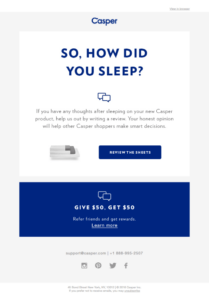
9. Sales Email Sequences
Salespeople must find efficient ways to attract prospects’ attention, nurture them, and turn them into customers, especially in SaaS businesses. They follow many cold sales techniques to achieve that, such as reaching out to people on social media like LinkedIn or approaching them on other networks.
But their most popular tactic across the years is cold emails. When a lead is qualified, sales teams need to build several appealing emails to entice subscribers to open them and hopefully complete the desired action.
Most of these emails are written in plain text in a more personal tone to make the interaction more authentic. As with other email sequence examples, timing here is key, so it’s important to reach out to sales-qualified leads (SQLs) early to capitalize on their recent interest. As for non-openers, you should find variations of the first email, probably by addressing different pain points.
Below are email sequence templates with a first touchpoint and a follow-up to get inspired:
Email Sequence Templates
1st Email Template
Subject line: [Name], let’s talk!
Hi there, [Name]!
How are you? I am [Name] from [Company name], and I recently saw your profile on [channel].
Our company offers solutions that can free your hands, such as:
- [Solution X]
- [Solution Y]
Do you find this information helpful? Otherwise, is there anyone in your business that could benefit from us? I would love to get in touch and discuss with them.
If you’re interested, reply to this email, specifying your availability for a quick call!
Kind regards,
[Your Name]
1st Follow-up Email Template
Subject line: [Name], I forgot to mention…
Hi [Name],
I hope you’re doing great!
I previously emailed you about helping companies like yours to [mention pain points/solutions offered], and I’m curious to know if you experience similar struggles at work.
Did you get the chance to check our website and spot something you’d love to discuss with us? Then we’d like to jump on a short call this week. Click the link below to choose a time and date that suits your schedule.
Best regards,
[Your Name]
You can tweak the templates above to create your own follow-up sequence with your brand’s tone of voice to create a consistent experience for readers across different channels.
Email Sequence Best Practices
If you’re convinced that automation workflows are what your marketing and sales team needs to elevate their work, here are some strategic steps to follow:
Step 1: Set Your Goals
To build a successful strategy, one of the most important first steps is to set clear goals. What exactly would you like to achieve with each sequence? How will you convey the appropriate messages to your audience, and what tools will you use?
You’re probably already familiar with the SMART goal framework, which stands for specific, measurable, attainable, relevant, and time-based.
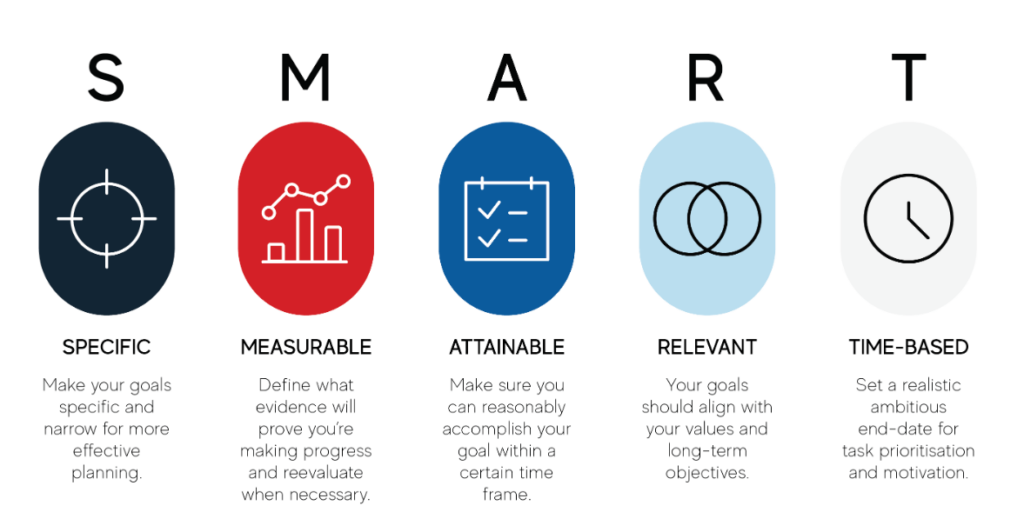
Moreover, it’s vital to have a clear overview of your customer journey and buyer personas to understand their pain points and what products/services they look for to resolve them.
Step 2: Choose An Email Service Provider
To create email sequences, you should acquire an email marketing service with excellent capabilities to set up autoresponders, automation workflows, and transactional emails. Many email marketing platforms offer premade automation recipes for popular sequences like the ones mentioned earlier and integrations with CRM solutions like Salesforce.
To set up your sequences or tweak the existing ones, you should follow the in/then conditional logic, selecting the triggers and the conditions for each sequence.
Here’s an onboarding sequence created with Moosend:
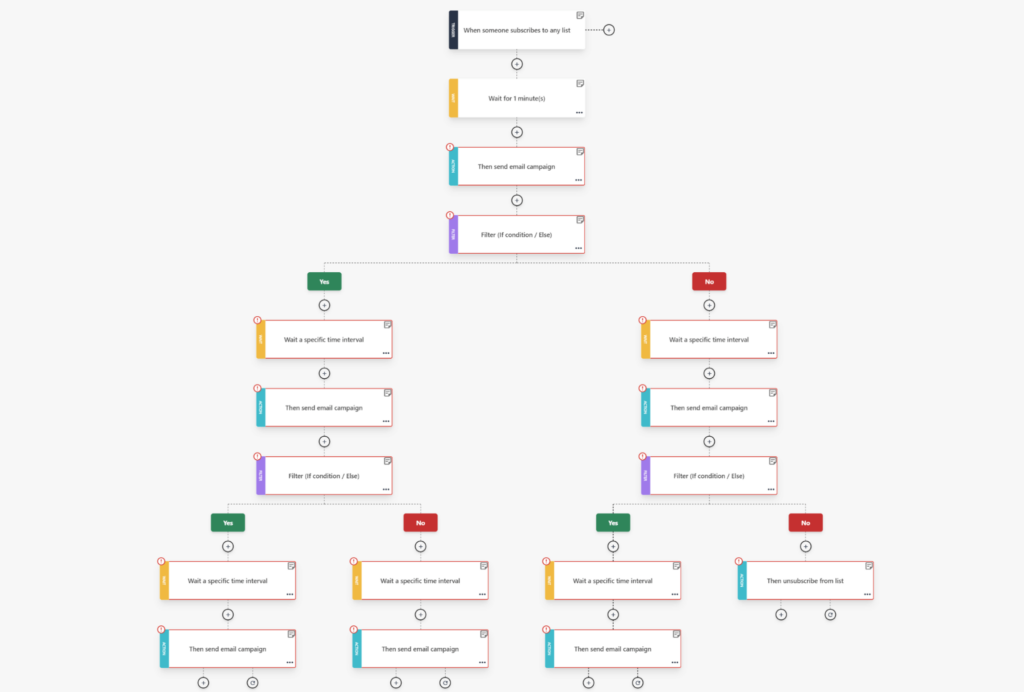
So if you’re new to email automation, find your top three ESPs based on your industry, and check their pricing and features pages to see which one covers your needs. Many offer trials to help you navigate the product before deciding.
You need to ensure that it provides what it promises, including a user-friendly interface and flexibility in pricing, especially for businesses in a scaling mode.
Step 3: Create Converting Email Sequences
As you move on from the more practical part, it’s time to get creative to deliver beautiful email sequences to your audience. You should create a unified experience for readers across those emails so that they recognize your brand faster.
Most email marketing platforms have newsletter templates that are easy to customize using intuitive editors to save time. Here are the main components of a clean-cut newsletter:
- Header
- Clean layout
- Background
- Visuals
- CTAs
- Email footer
The copy plays a key role in attracting the right audience, starting from the subject line, the first email component they see landing in their mailbox. To write efficient copy, adding a sense of urgency when you see fit is wise, especially for discounts and offers.
Addressing pain points and emotions is also valuable, as you need to build trust with your audience. An empathetic, personal tone combined with authenticity is usually a golden ticket. Plus, actionable copy usually motivates readers to decide faster. The email sequence examples shared in the previous section check all those boxes, so revisit them to get new ideas.
Step 4: Monitor The Email Metrics
When you start sending out email sequences, it’s essential to keep track of your email metrics to see what works and which areas need improvement. For example, you may need to segment your lists differently for better personalization.
Here are the metrics you should look closely at:
- Conversions
- Click-through rate
- Open rates
- Bounce rate
- Unsubscribe rate
Initially, it’s important to check email benchmark data in your industry to know where to aim. However, remember this is just an indicator, as every audience has unique characteristics and consumer habits.
The Takeaways
It’s official – crafting email sequences is a great starting point if you want to put marketing personalization in the game. Study the customer’s journey in-depth, prepare effective lead magnets and landing pages, and nurture your subscribers with interesting content.
If you’re looking for a marketing automation platform to streamline this process effectively using a user-friendly dashboard, sign up for a Moosend account today or request a 30-day free trial to check out features.
Email Sequences FAQs
We’ll close with a quick round of questions regarding email sequences:
1. What are the types of email sequences?
The most popular email sequences are: 1) Welcome, 2) Onboarding, 3) Lead nurturing, 4) Re-engagement, 5) Cross-sell/Upsell, 6) Cart abandonment, 7) Renewal, 8) Feedback, and 9) Cold sales.
2. What’s the difference between drip campaigns and email sequences?
Drip campaigns are automated emails with more static content, while email sequences have more dynamic elements for optimal personalization.
3. How many emails should be in a sequence?
It depends on the goal of the workflow, but it usually ranges from 2 to 6 – more than that may overwhelm the audience and lead to negative consequences, such as unsubscribes.




 Published by
Published by 